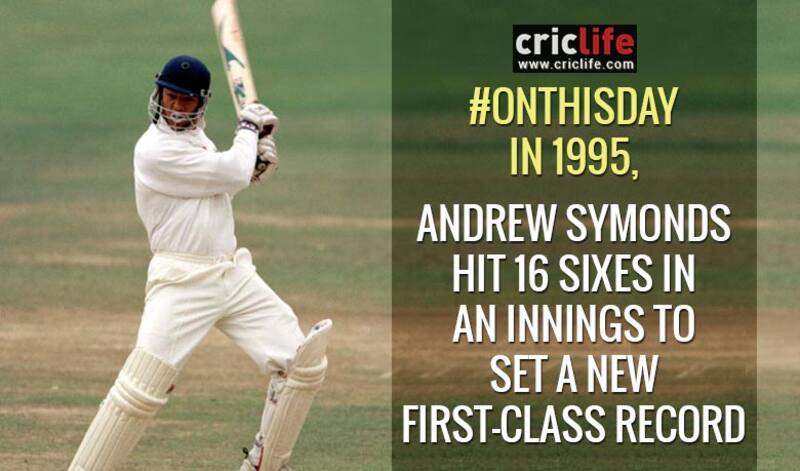
Chinmay Jawalekar
A self-confessed cricket freak, Chinmay Jawalekar is a senior Writer with CricketCountry. When not writing or following cricket, he loves to read, eat and sleep. He can be followed at @CricfreakTweets.
Written by Chinmay Jawalekar
Published: Aug 25, 2016, 07:55 PM (IST)
Edited: Aug 25, 2016, 07:55 PM (IST)

The word ‘swagger’ is mostly associated with the legendary batsman Sir Viv Richards. But someone like Andrew Symonds, whose name may never be taken in the same breath with Richards’, too had a swagger from the beginning. And later on, the same swagger went on to define his style of play. We shall come to it later, and let’s talk about his earlier days first. Symonds had a nomadic life. One half of his biological parents were of West Indian origin while the other half was either Danish or Swedish. He was born in Birmingham, England, and later adopted by a couple who relocated to Australia when he was just three months old.
As he grew up, with keen interest in cricket, this curious ancestry made him eligible to play for three teams — England, by the virtue of being country of his birth; West Indies, due to his ancestry and Australia, his adopted nation. He played his age group cricket in Australia where he grew up. In 1994-95, he was picked for the Australian Under-19 squad to tour India. The likes of Mike Hussey and Brett Lee were his teammates while Australia’s future ‘tormentor’ VVS Laxman was in the opposition camp. A good showing there backed up with some consistent performances opened the Queensland senior side’s doors for him.
The backdrop
The same season, he scored unbeaten 108 for Queensland against the touring English side. It was this knock which played a crucial role in Symonds signing a contract with English County side Gloucestershire for the 1995 season. ‘Roy’, as he is famously known as, arrived in the country of his birth with a bang. On his County Championship debut, Symonds played a blistering knock of 161, which came in only 140 balls with 21 fours and 4 sixes. In his next game against Somerset, he smashed another hundred.
After hitting 3 hundreds in the season, Symonds arrived in the Welsh town of Abergavenny with his side Gloucestershire to face Glamorgan. The hosts won the toss and elected to bat first. Javagal Srinath, who was India’s star bowler back then, spearheaded Gloucestershire’s attack and picked up 4 wickets in the innings as Glamorgan ended their first innings on 334. The innings was lit up by 3 half-centuries by their skipper Hugh Morris (67), David Hemp (71) and tail-ender Darren Thomas (78).
When it happened
The real action began on day two when Gloucestershire’s innings started. Symonds came out to bat with the score reading 79 for 4. It soon became 79 for 5, with the visitors looking in all sorts of trouble. From here, Symmo’s whirlwind knock took off, as he produced a fantastic display of counter-attacking cricket. He looked unflustered from what was happening around him and started smashing the bowlers all around the park. He first got an able ally in wicketkeeper-batsman Richard Williams (52), with whom he added 213 for the 6th wicket, and later in Srinath (39), with whom he picked quick 84 runs for the 8th wicket.
In the process, an unruffled Symonds went on to hit sixes at will. He completed 1,000 runs in his maiden County season when he was on 133. Later, when he hit the record 16th six of his innings, he broke John Reid’s First-Class record of 15 sixes. He remained unconquered on 254 off just 206 balls even as his team got dismissed for 461. This was a huge moment not just in the context of the game, but also Symonds’ career. The knock shot the then 20-year-old cricketer on the radar of Australian and English selectors for selection. He went on to hit 76 off 65 in the second innings and add another 4 sixes, taking his match tally to 20 maximums. The match eventually ended in a draw and he played a pivotal role in it.
What followed?
Brief scores:
Glamorgan 334 (David Hemp 71, Hugh Morris 67; Martyn Ball 4 for 54, Javagal Srinath 4 for 74) and 471 (Matthew Maynard 164, David Hemp 157; Javagal Srinath 9 for 76) drew with Gloucestershire 461 (Andrew Symonds 254*; Robert Croft 3 for 90, Steven Watkin 3 for 122) and 293 for 9 (Andrew Symonds 76, Mark Alleyne 64, Monte Lynch 56; Darren Thomas 5 for 99)
(A self-confessed cricket freak, Chinmay Jawalekar is a senior writer with CricLife and CricketCountry. When not writing or following cricket, he loves to read, eat and sleep. He can be followed here @CricfreakTweets)
This website uses cookies so that we can provide you with the best user experience possible. Cookie information is stored in your browser and performs functions such as recognising you when you return to our website and helping our team to understand which sections of the website you find most interesting and useful.
Strictly Necessary Cookie should be enabled at all times so that we can save your preferences for cookie settings.
If you disable this cookie, we will not be able to save your preferences. This means that every time you visit this website you will need to enable or disable cookies again.
